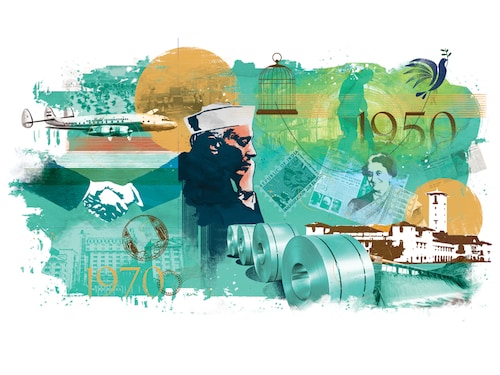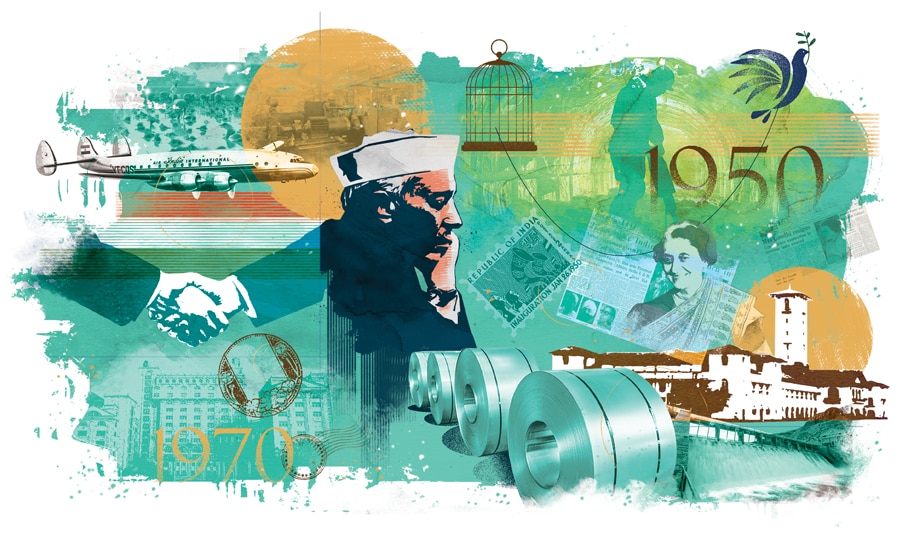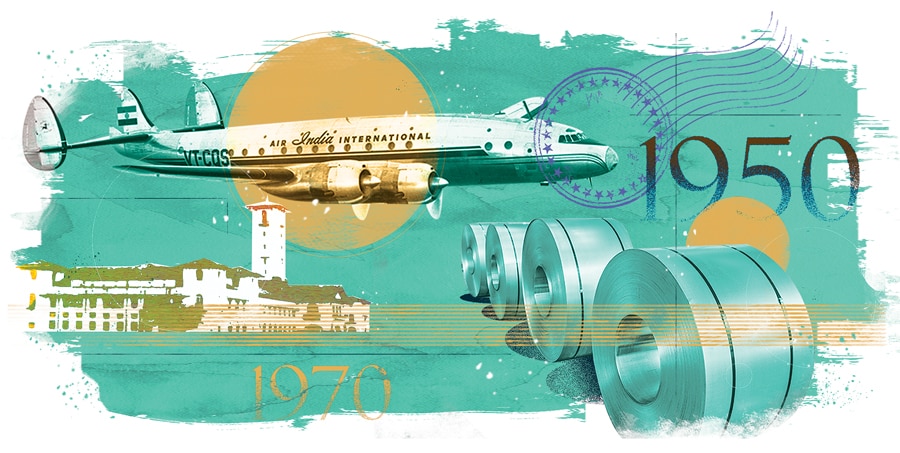1950s to 1970s: How India's economic DNA got hard-coded
The socialist foundation of nation-building laid by Nehru and Gandhi continues to influence policy and politics even today


 Illustration: Chaitanya Dinesh Surpur [br]The 73 years after India got its independence can be broadly sliced into three phases: The three decades post-1947 till the 70s was when Jawaharlal Nehru and, then, his daughter Indira Gandhi went about the task of institution and nation-building. The 80s was arguably a lost decade, with Indira pursuing her gambits of nationalising banks and loan melas when she should have been ushering economic reform and deregulation. That eventually came in the 90s when the country’s coffers had dried up. The last three decades have transformed India, made a fraction of Indians richer, but poverty and inequality are still fetters in the eighth decade after India became a free country. Forbes India dives deep into these three phases of freedom
Illustration: Chaitanya Dinesh Surpur [br]The 73 years after India got its independence can be broadly sliced into three phases: The three decades post-1947 till the 70s was when Jawaharlal Nehru and, then, his daughter Indira Gandhi went about the task of institution and nation-building. The 80s was arguably a lost decade, with Indira pursuing her gambits of nationalising banks and loan melas when she should have been ushering economic reform and deregulation. That eventually came in the 90s when the country’s coffers had dried up. The last three decades have transformed India, made a fraction of Indians richer, but poverty and inequality are still fetters in the eighth decade after India became a free country. Forbes India dives deep into these three phases of freedom
Looking back from the vantage point of 2019, it is possible to be either highly laudatory or highly critical of India’s leadership during the first three decades of India’s independence, decades in which the country was led by the father-daughter duo of Jawaharlal Nehru and Indira Gandhi, barring a short 19-month period when Lal Bahadur Shastri was prime minister. India’s post-independence DNA was largely set by Nehru and Gandhi, and everything, the good, the bad and the ugly parts, can be traced to their stewardship of the nation in these foundational years.
Through these decades, despite Gandhi’s Himalayan blunder of the Emergency (1975-77), when political rivals and civil activists were thrown in jail, India remained a democracy, with reasonably robust institutions, from an independent judiciary to free and fair elections. Some credit for this must indeed go to Nehru, but not all of it. The truth is India has always been a pluralistic place, and the Indic mindset, argumentative and fractious but always accepting of difference and diversity, is what enabled Nehru to build a superstructure of democratic institutions on top of it.
Look around in the neighbourhood, and the answer will stare you in the face. States and people who were supposedly part of the same national fabric before 1947 are now in shambles. Without the sub-stratum of a pre-existing pluralistic India, Nehru would never have been able to build a democratic edifice that has held firm for 72 years—and counting. His greatest contribution was not necessarily his Idea of India, but his long tenure of 17 years at the helm. Nehru contributed to nation-building merely by being there as a reassuring presence for so long. None of our neighbours had this advantage.
Of course, Nehru is also credited with creating the new “temples of modern India” (the IITs, giant dams, and huge public sector behemoths in steel and heavy engineering), but would any other leader have done anything different? Long before the IITs came up in the 1960s, the Indian Institute of Science and Tata Iron and Steel Co had been conceived by the Tatas in 1909 and 1907 under British Raj. The IITs would have happened no matter who ruled India. So would the big dams and steel and cement plants, for in those years it was the heavy, investment-led Soviet model of development that Indian leaders were in awe of.[br]True, the first three decades of independence were also decades of missed opportunities, of failed attempts to make our people better educated and healthier. Where Japan, China and Southeast Asia succeeded in mass empowerment, we created an elite that could compete with the best while the masses remained ill-equipped to lift themselves out of poverty and illiteracy. We are still paying the price for these fundamental failures.
However, it make little sense to be hypercritical of our socialistic misadventures of the first three decades of independence. Nehru was, of course, a Fabián socialist of sorts, and his daughter, who faced stronger political challenges in the initial period of her tenure, found it politically expedient to kowtow to Left-wing ideologies. From bank and insurance nationalisation to levying the daftest and most extortionate marginal tax rate in the world—93.5 percent in 1970, which went up to 97.5 percent along with the surcharge of 15 percent for incomes above ₹2 lakh—she did not miss any opportunity to take India down the wrong path to economic progress. But if one considers the reality that Finance Minister Nirmala Sitharaman, in her recent Union Budget, levied additional tax surcharges on incomes above ₹2 crore, we can see vestiges of that 1970s mindset even now.
While judging Nehru and Gandhi we need to understand that they were socialist at a time when it was fashionable to be so. The newly decolonised countries saw redistribution of wealth and incomes as the surest way to end poverty, and towards this end they all ended up creating all-powerful states. Barring a few tiny, renegade countries (South Korea, Singapore, Taiwan), which went decidedly the other way, the rest of the developing countries were mostly in sync with what Nehru and Gandhi were doing in India. Nehru was not an outlier in the context of his time.
A quick look at the key legislative initiatives of the first 30 years (1947-77) will give us these high points. The control and statist mindset came in early, with the Controller of Capital Issues being one of the first major institutions created by a newly independent India in 1948, followed by the Planning Commission (1950). This, coupled with over-protection of labour, ensured that India would never grow either jobs or the economy till after 1991. The Minimum Wages Act and the Factories Act also came the same year, followed by the Industries (Development and Regulation) Act in 1951, giving us an early warning sign of the oncoming licence-permit raj.
The idea of nationalising high-profile companies started under Nehru, with Air India being taken over in 1953 and life insurance in 1956. The state-led model of growth acquired a momentum of its own with the adoption of the Industrial Policy Resolution (IPR) of 1956, which promised to keep the public sector at the “commanding heights” of the economy, with an expressed preference for a “socialist pattern of society”. It was this IPR that set the tone for wholesale distrust of the private sector, which was then carried to absurd lengths under Gandhi.
The beginnings of the licence-permit raj can be traced to this period, and peaked during Gandhi’s government. The excusable mistakes of Nehru got compounded, taking on a life of their own in the late 60s and 70s. In a short span of 10 years, banks were nationalised (1969), followed by coal mines (1971), general insurance (1972), and sick textile companies (1974). Sheer inertia ensured that even after Gandhi was massively defeated in the 1977 general elections, the triumphant Janata Party, a ragtag bunch of dyed-in-the-wool socialists and right-wingers from parties like the Jana Sangh, continued along the same path. It was under the Janata Party that the Right to Property stopped being a fundamental right. Today, the Supreme Court frequently frets about executive attempts to tinker with the basic features of the Constitution, but in 1978, that biggest assault on a basic feature, simply did not register on the radar of constitutional pundits. The last burst of socialism struck India in 1980, when Gandhi, after returning to power with a bang, nationalised six more banks.
Control of banks, insurance, coal, power, steel, ports, airports and railways ensured that by the mid-1970s the state dominated almost all parts of the economy. But there was one sector, largely private, which was still dominated by private entrepreneurs: Agriculture. The assault on this redoubt of private ownership began in 1965, with the Food Corporation of India and the Agriculture Prices Commission being set up, all with the holy intention of helping the “poor farmer”. An entrepreneurial sector which still dominated the economy was put on state crutches, aided by minimum support prices and subsidies on fertilisers and other inputs. But with the Essential Commodities Act having been legislated a decade earlier in 1955 to protect the urban classes from price increases, the state denied the farmer the one thing that would have enabled him to prosper: A national market for agri-produce, especially food products.
The follies courted by the Indian state in the first three decades are still with us, as the same vested interests that gained from these state interventions refused to allow agriculture to find its natural free-market mojo. Even today, the Narendra Modi government is yet to free agriculture from the depredations of the sixties.
To maintain this overwhelming dominance of the state in so many areas, we enacted laws to control factor markets like land and labour—both areas where even post-liberalisation governments have been hesitant to reform. Follies like the over-protection of labour continue to have echoes even today, with the Modi government talking of legislating a new Minimum Wages Act. The Urban Land (Ceiling and Regulation) Act, legislated in 1976, may be gone, but the United Progressive Alliance (UPA) regime introduced a more stringent land acquisition law that distorts the land markets even further, by mandating the payment of two and four times market prices for rural and urban land acquired for public purposes like infrastructure. India thus has the most inflexible factor markets, and despite tentative nibbles at reform—a small change in the Apprentices Act here and permissions to offer fixed-term labour contracts there—few governments have been willing to radically reform these markets.
In the first three decades, the answer to every economic problem was always the same: A greater role for the state. A country perennially short of foreign exchange reserves legislated a Foreign Exchange Regulation Act in 1973. A country short of energy resources got Indian Oil and ONGC (1955). A country short of long-term finance got development financial institutions as early as 1948. Shortage anywhere meant the state had to step in to address the issue. It was never assumed that there could be other answers to the problem. Reason: It enabled a small group of powerful politicians and bureaucrats to control enormous resources and sources of patronage.
During the peak soak-the-rich period of the late 1960s and early 1970s, politicians reduced profit to a bad word, and businessmen were made the fall guys for political and economic failures. By 1969, we had a Monopolies and Restrictive Trade Practices Act, ostensibly to prevent unfair trade practices, but it neither managed to contain non-competitive practices, nor prevented the concentration of wealth. In 1970, we legislated the highest personal tax rates in the world.
Looking back from today’s high perch, where all aspects of the past are being critically re-evaluated, it is possible to critique both Nehru and Gandhi for leading the economy towards the dead end of statist socialism. But, despite the 1991 reforms and economic liberalisation, if one were to listen to the political rhetoric and approaches of a Narendra Modi today, it is possible to trace an invisible link to the socialist economics of those years. The Nehru-Gandhi DNA permeates the body politic even today, despite the political transition away from Congress to BJP, and the shift from a licence-permit rate to a regulator-managed raj.
Despite the 1991 reforms, control mindsets have ensured that our corruption scams have only gotten bigger. This peaked during the UPA regime, where we saw major scams in the allocation of spectrum and coal mines. This has been followed by new suspicions about crony businesses, leading to another era of mistrust between government, business and the general public. Modi, despite his right-wing credentials, continues to be a reluctant privatiser of banks and other public sector companies.
The first three decades may be a distant memory, but to assume that they are gone forever would be a mistake. We still have not fully abandoned some of the mindsets and approaches of that era.
â— The author is Editorial Director, Swarajya magazine
First Published: Aug 10, 2019, 06:17
Subscribe Now